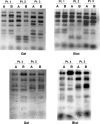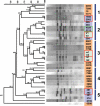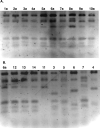Restriction fragment length polymorphism typing demonstrates substantial diversity among Pneumocystis jirovecii isolates
- PMID: 19795979
- PMCID: PMC2803681
- DOI: 10.1086/644643
Restriction fragment length polymorphism typing demonstrates substantial diversity among Pneumocystis jirovecii isolates
Abstract
Better understanding of the epidemiology and transmission patterns of human Pneumocystis should lead to improved strategies for preventing Pneumocystis pneumonia (PCP). We have developed a typing method for Pneumocystis jirovecii that is based on restriction fragment length polymorphism (RFLP) analysis after polymerase chain reaction amplification of an approximately 1300 base-pair region of the msg gene family, which comprises an estimated 50-100 genes/genome. The RFLP pattern was reproducible in samples containing >1000 msg copies/reaction and was stable over time, based on analysis of serial samples from the same patient. In our initial analysis of 48 samples, we found that samples obtained from different individuals showed distinct banding patterns; only samples obtained from the same patient showed an identical RFLP pattern. Despite this substantial diversity, samples tended to cluster on the basis of country of origin. In an evaluation of samples obtained from an outbreak of PCP in kidney transplant recipients in Germany, RFLP analysis demonstrated identical patterns in samples that were from 12 patients previously linked to this outbreak, as well as from 2 additional patients. Our results highlight the presence of a remarkable diversity in human Pneumocystis strains. RFLP may be very useful for studying clusters of PCP in immunosuppressed patients, to determine whether there is a common source of infection.
Figures



Similar articles
-
Absence of dihydropteroate synthase gene mutations in Pneumocystis jirovecii strains isolated from Aegean region of Turkey.Parasitol Res. 2018 Oct;117(10):3103-3108. doi: 10.1007/s00436-018-6004-6. Epub 2018 Jul 19. Parasitol Res. 2018. PMID: 30027382
-
Selective expression of Pneumocystis antigens in different patients during a suspected outbreak of Pneumocystis pneumonia.mBio. 2025 May 14;16(5):e0069225. doi: 10.1128/mbio.00692-25. Epub 2025 Apr 17. mBio. 2025. PMID: 40243367 Free PMC article.
-
Variation in the major surface glycoprotein genes in Pneumocystis jirovecii.J Infect Dis. 2008 Sep 1;198(5):741-9. doi: 10.1086/590433. J Infect Dis. 2008. PMID: 18627244 Free PMC article.
-
Strain typing methods and molecular epidemiology of Pneumocystis pneumonia.Emerg Infect Dis. 2004 Oct;10(10):1729-35. doi: 10.3201/eid1010.030981. Emerg Infect Dis. 2004. PMID: 15504257 Free PMC article. Review.
-
Molecular diagnosis of Pneumocystis pneumonia.FEMS Immunol Med Microbiol. 2005 Sep 1;45(3):405-10. doi: 10.1016/j.femsim.2005.06.006. FEMS Immunol Med Microbiol. 2005. PMID: 16061360 Review.
Cited by
-
Trimethoprim resistance of dihydrofolate reductase variants from clinical isolates of Pneumocystis jirovecii.Antimicrob Agents Chemother. 2013 Oct;57(10):4990-8. doi: 10.1128/AAC.01161-13. Epub 2013 Jul 29. Antimicrob Agents Chemother. 2013. PMID: 23896474 Free PMC article.
-
Unanticipated Global Emergence of Multiple Pneumocystis jirovecii Mutants Selected by Mycophenolic Acid Driving Increasing Outbreaks in Solid Organ Transplant Recipients.medRxiv [Preprint]. 2025 Jun 17:2025.06.17.25328583. doi: 10.1101/2025.06.17.25328583. medRxiv. 2025. PMID: 40585156 Free PMC article. Preprint.
-
Characterization of the meiosis-specific recombinase Dmc1 of pneumocystis.J Infect Dis. 2010 Dec 15;202(12):1920-9. doi: 10.1086/657414. Epub 2010 Nov 4. J Infect Dis. 2010. PMID: 21050123 Free PMC article.
-
Investigating Clinical Issues by Genotyping of Medically Important Fungi: Why and How?Clin Microbiol Rev. 2017 Jul;30(3):671-707. doi: 10.1128/CMR.00043-16. Clin Microbiol Rev. 2017. PMID: 28490578 Free PMC article. Review.
-
Estimated Burden of Fungal Infections in Oman.J Fungi (Basel). 2020 Dec 23;7(1):5. doi: 10.3390/jof7010005. J Fungi (Basel). 2020. PMID: 33374846 Free PMC article.

